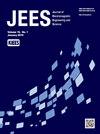Estimation of Electromagnetic Field Penetration into Concrete Buildings Using a Theoretical Approach Considering External Environmental Factors
IF 1.7
3区 工程技术
Q3 ENGINEERING, ELECTRICAL & ELECTRONIC
Journal of electromagnetic engineering and science
Pub Date : 2023-05-31
DOI:10.26866/jees.2023.3.r.161
引用次数: 0
Abstract
In this paper, we propose a theoretical approach to estimate the power level of electromagnetic waves radiated into a structure by a specific external source. The target structure is a multistory building on a university campus that is used primarily for academic purposes and is much larger than the target wavelength. To verify the accuracy and efficiency of the proposed theoretical approach, measurements were carried out and a commercially available simulation tool, Wireless Insite, was adopted. We then analyzed the influence of an area of vegetation as an external environmental factor that could affect the radiated electromagnetic waves because of its location in front of the target structure. For this, a precise simulation environment was designed to derive the quantitative values of the electromagnetic attenuation caused by the external environmental factor. Furthermore, those values were applied to the theoretical approach. The results of the theoretical approach accounting for the external environmental factor were similar to those of the actual measured results. The results were also similar to those of the simulation tool, Wireless Insite, but the theoretical approach provided more efficient analysis results in terms of time consumption and computer resources.用考虑外部环境因素的理论方法估算电磁场对混凝土建筑的穿透力
在本文中,我们提出了一种理论方法来估计由特定外部源辐射到结构中的电磁波的功率水平。目标结构是大学校园内的多层建筑,主要用于学术目的,并且比目标波长大得多。为了验证所提出理论方法的准确性和效率,进行了测量,并采用了商用仿真工具Wireless Insite。然后,我们分析了植被区域作为外部环境因素对辐射电磁波的影响,因为它位于目标结构的前面。为此,设计了精确的仿真环境,推导出外部环境因素引起的电磁衰减的定量值。此外,将这些值应用于理论方法。考虑外部环境因素的理论方法的结果与实际测量结果相似。结果也与仿真工具Wireless Insite的结果相似,但理论方法在时间消耗和计算机资源方面提供了更有效的分析结果。
本文章由计算机程序翻译,如有差异,请以英文原文为准。
求助全文
约1分钟内获得全文
求助全文
来源期刊

Journal of electromagnetic engineering and science
ENGINEERING, ELECTRICAL & ELECTRONIC-
CiteScore
2.90
自引率
17.40%
发文量
82
审稿时长
10 weeks
期刊介绍:
The Journal of Electromagnetic Engineering and Science (JEES) is an official English-language journal of the Korean Institute of Electromagnetic and Science (KIEES). This journal was launched in 2001 and has been published quarterly since 2003. It is currently registered with the National Research Foundation of Korea and also indexed in Scopus, CrossRef and EBSCO, DOI/Crossref, Google Scholar and Web of Science Core Collection as Emerging Sources Citation Index(ESCI) Journal. The objective of JEES is to publish academic as well as industrial research results and discoveries in electromagnetic engineering and science. The particular scope of the journal includes electromagnetic field theory and its applications: High frequency components, circuits, and systems, Antennas, smart phones, and radars, Electromagnetic wave environments, Relevant industrial developments.
 求助内容:
求助内容: 应助结果提醒方式:
应助结果提醒方式:


